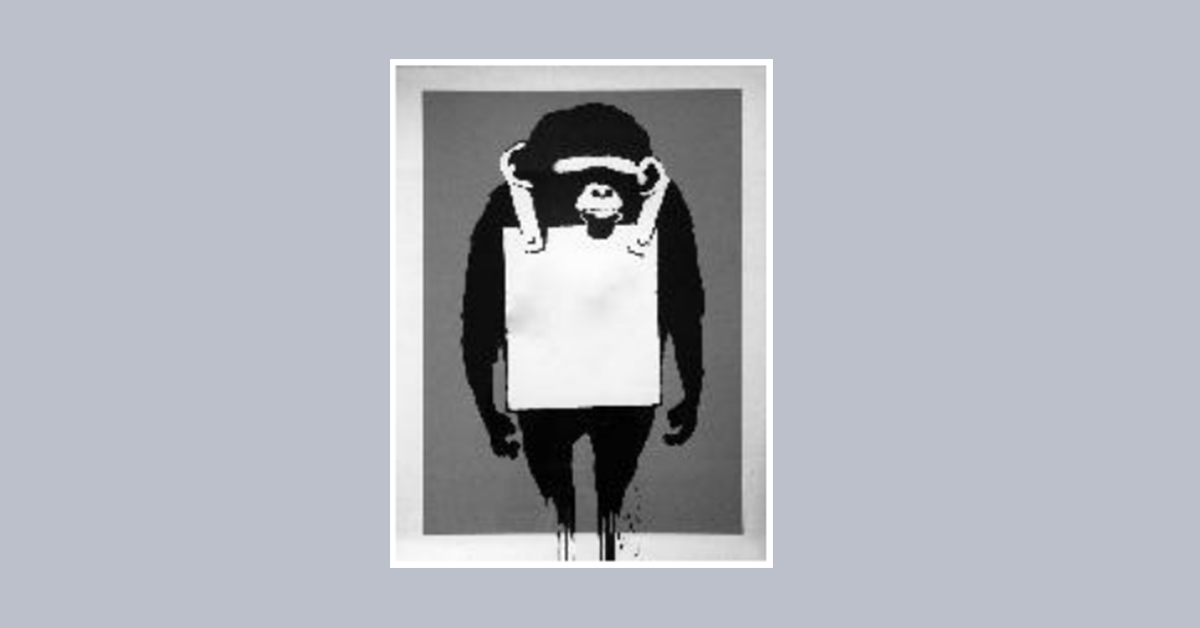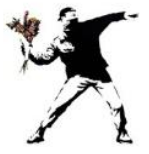
01 Feb Banksy’s trademarks: he who laughs last, laughs loudest
Background
In November 2021 we announced on Curell Suñol’s blog that Banksy lost his EU trademark number 12575155  (the flower thrower) and, subsequently, in another article in February 2022, we explained that the nightmare continued because other EU trademark registrations were declared invalid as well, all of them having been applied for in the name of Pest Control Office Limited (Pest Control). This company acts as Banksy’s legal representative to prevent his identity from becoming public. Out of 15 trademark registrations consisting of Banksy’s works that were registered before the European Union Intellectual Property Office (EUIPO) in the name of the said company, 7 have been the subject matter of invalidity actions brought by Full Colour Black Limited (Full Colour Black). We would now like to focus on the path taken by EU trademark No. 17981629
(the flower thrower) and, subsequently, in another article in February 2022, we explained that the nightmare continued because other EU trademark registrations were declared invalid as well, all of them having been applied for in the name of Pest Control Office Limited (Pest Control). This company acts as Banksy’s legal representative to prevent his identity from becoming public. Out of 15 trademark registrations consisting of Banksy’s works that were registered before the European Union Intellectual Property Office (EUIPO) in the name of the said company, 7 have been the subject matter of invalidity actions brought by Full Colour Black Limited (Full Colour Black). We would now like to focus on the path taken by EU trademark No. 17981629  , the only one where Pest Control appealed its declaration of invalidity.
, the only one where Pest Control appealed its declaration of invalidity.
The beginning of the story is very similar to the one we explained previously. Banksy first painted his monkey with a banner around his neck reading “Laugh now, but one day we’ll be in charge” in 2002, as the piece was originally commissioned by a Brighton nightclub. Since then, the image, which the EUIPO considers “possibly the most iconic and famous of his works”, has served as the inspiration for countless works of art, including a version that was sold for $2.9 million.
Pest Control applied for EU trademark No. 17981629 in November 2018 and it was registered in June 2019. Full Colour Black filed an invalidity action against it in November 2019, as it did with the “flower thrower” case, among others. The result was the same and, on 18 May 2021, the Cancellation Division upheld the invalidity claim, considering that the trademark had been filed in bad faith because, inter alia, there had never been any intention to use it and the applicant had the purpose to circumvent limitations of copyright law, i.e. the same arguments set out in our previous articles.
Why is this case worth explaining?
On 19 July 2021, Pest Control lodged an appeal against the unfavourable decision and on 25 October 2022, the Fifth Board of Appeal of the EUIPO issues a decision by which the appeal is upheld, ruling not only on the absence of bad faith, but also on the other grounds raised by Full Colour Black as regards the lack of distinctive character and descriptiveness of the contested mark.
Distinctive character of the mark
The Fifth Board of Appeal rejects the last two grounds as it does not find sufficient evidence to support them. The contested sign, consisting of the representation of an ape carrying a blank banner, is not a simple decorative element which will go unnoticed, but is rather an unusual combination of elements, which is eye-catching and which consumers will be aware of. Similarly, the Board considers that the fact that the mark is protected by copyright is not an obstacle to the protection of the mark and does not make it descriptive. Thus, the Board understands that the same work of art or sign may be protected as an original creative work under copyright law and as an indication of commercial origin under trademark law. These are different exclusive rights, based, on the one hand, on the original character of a creation and, on the other hand, on the capacity of a sign to distinguish function as a badge of trade of goods and services.
Use issues
As to the finding of bad faith, when examining the intention to use the sign as such, the Board points out that, in this case, the invalidity action was brought half a year after the registration of the mark, which was therefore still within the 5-year grace period established for the obligation to use it. The owner of a trademark is free to decide when to start using its registered trademarks (within these five years) and the Board finds that the general circumstances do not allow to assume that there was no intention to use the trademark.
Besides, the circumstances that the artwork has been made public permitting its copy and use under certain (non-commercial) circumstances and also the fact that some third parties have used it as decorative features on their merchandising goods does not indicate any lack of intention to use of the EUTM proprietor when he filed the contested mark.
Regarding the finding of bad faith on the basis that the filing of the contested mark was done with the purpose of prohibiting the use of the artwork it contained which had been previously permitted, the Board considers that any copyright owner can withdraw any permission to use their work of art and that this can also be done through trademark law once the work of art is registered as a trademark. Moreover, the purpose of trademark registrations is precisely to prevent third parties from using them and this does not imply any dishonest practice.
Copyright issues
With respect to Banksy’s own earlier statements that “copyright is for losers”, the Board makes the (correct in our view) distinction between his freedom of speech (which is a Fundamental Right) as an individual and the corporate intent of the trademark owner, Pest Control. Therefore, these statements are not sufficient to establish that there is no real intention to use the mark.
Finally, regarding the argument that the application was filed in bad faith because its aim was to circumvent the provisions of copyright law, the Board considers that although copyright law gives a limited protection (70 years after the death of its author) whereas in trademark law protection may be, in principle, indefinite, this does not imply that the filing of a trademark consisting of an artwork protected by copyright law is automatically unlawful or that it seeks to circumvent the “limitations” of such law.
In addition, with regards to the assumption that the need of staying anonymous was the reason to prefer trademark protection to copyright protection, even if it would be correct, this cannot justify a finding that the EUTM proprietor had no intention to use the contested mark. In any event, the decision of the Fifth Board of Appeal is also key for Banksy’s interest not to reveal his identity, an extraordinary goal after so many years. This is undoubtedly one of the most positive aspects of his victory, as Banksy will be able to remain in the shadows defending his rights.
All in all, the Fifth Board of Appeal annuls the previous decision, confirming the registration of EU trademark No. 17981629  and orders Full Colour Black to pay the costs of the cancellation and appeal proceedings. The words that the monkey carried on the banner in its first appearance [Laugh now, but one day we will rule] were prophetic because as the popular saying goes: he who laughs last, laughs loudest.
and orders Full Colour Black to pay the costs of the cancellation and appeal proceedings. The words that the monkey carried on the banner in its first appearance [Laugh now, but one day we will rule] were prophetic because as the popular saying goes: he who laughs last, laughs loudest.
Author: Berta Benet, Lawyer
Notes:
If you wish to read the decision of the Fifth Board of Appeal, please click this link:



